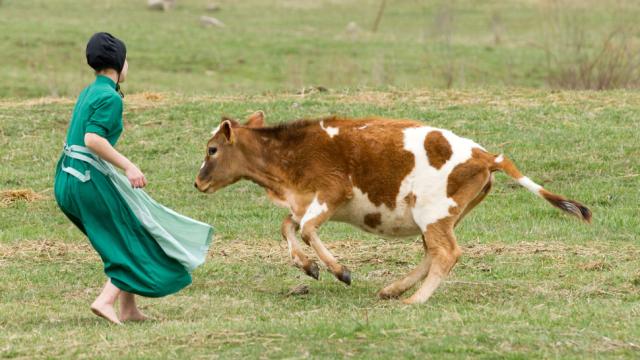For years, scientists have known that growing up on a farm protects children from asthma, but the reasons for this weren’t entirely clear. A fascinating comparative analysis of Amish and Hutterite farming communities has finally uncovered the specific aspects of farm life that are responsible for this built-in immune protection.
An Amish girl chases a cow from the outfield during a baseball game in Bergholz, Ohio. (Image: Associated Press/Scott R. Galvin)
In a new study published in the New England Journal of Medicine, researchers from the University of Chicago Medical Center and the University of Arizona have shown that substances found in house dust in Amish homes have a profound impact on the development of the body’s innate immune system in ways that protect children from asthma. Revealingly, the same could not be said for Hutterites, who share similar ancestry, lifestyles and cultural values. But it’s the differences between these two farming communities that shed light on the reasons why.
The American Amish and Hutterite communities were established by immigrants from Central Europe in the 18th and 19th centuries. Consequently, they provide an incredible opportunity for scientists to conduct comparative analyses; the Amish and Hutterites not only share genetic ancestry, they also share similar lifestyles and customs, such as a Germanic diet, having large families, breastfeeding, drinking raw milk, not allowing indoor pets and favouring childhood vaccinations.
But these communities differ in one very important way: They engage in different farming practices. The Amish still cling to traditional methods, such as living on single-family dairy farms and relying on horses for fieldwork and transportation. The Hutterites, by contrast, live on large communal farms and use modern, industrialised farm machinery. As a result, Hutterite children aren’t exposed to farm animals to the same degree that Amish children are.
Over the years, researchers have noticed a disparity in the prevalence of asthma between the two groups. Around five per cent of Amish children aged six to 14 have asthma, which is about half of the US average. By contrast, around 21 per cent of Hutterite children have asthma. As study co-author Carole Ober put it in a press statement, that’s a “whopping discrepancy”.

Hutterite women return from working in the fields at Greenwood Hutterite Colony near Delmont, South Dakota. (Image: Rainer Mueller)
To figure out what’s going on, the researchers studied 60 Amish and Hutterite children aged seven to 14. In addition to performing genetic analyses, the researchers compared the types of immune cells in their blood, collected dust from their homes and measured the amount of microbes in the homes of both communities.
A key discovery was the presence of neutrophils among Amish children — blood cells that are crucial to fighting infections. They also found a lack of eosinophils among the Amish, which promote allergic reactions, such as inflammation. Genetic analysis also showed that Amish children have a more reactive immune system.
In a follow-up to these findings, immunologist Donata Vercelli exposed genetically modified mice to house dust extracted from the homes (these mice were engineered to have weakened immune responses). She found that the airways of mice exposed to Amish dust were protected from asthma-like responses to allergens. The same could not be said for mice exposed to Hutterite dust. The dust collected from Amish homes contained more microbes — 6.8 times more to be precise.
“Neither the Amish nor the Hutterites have dirty homes,” explained Ober. “Both are tidy. The Amish barns, however, are much closer to their homes. Their children run in and out of them, often barefoot, all day long. There’s no obvious dirt in the Amish homes, no lapse of cleanliness. It’s just in the air, and in the dust.”
This study strongly suggests that early and frequent exposure to farming microbes, particular those that come from livestock, boosts Amish children’s disease-fighting immune system. The authors hope that these findings will point the way towards therapies or medicines that will help to prevent asthma and other allergies. As Ober put it, “You can’t put a cow in every family’s house, but we may be able to protect children from asthma by finding a way to re-create the time-tested Amish experience.”
